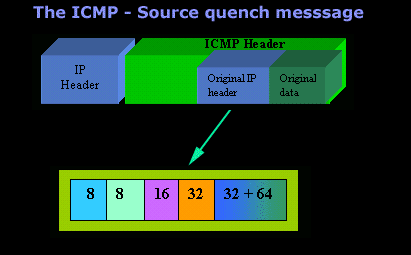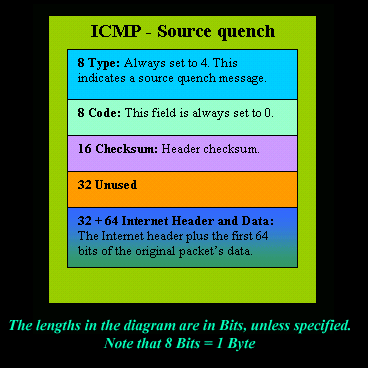ICMP - Source
Quench Message
Introduction
The
ICMP - Source quench
message is one that can be generated by either a
gateway or host. You won't see any such message
pop up on your workstation screen unless you're
working on a gateway which will output to the
screen all ICMP messages it gets. In short, an
ICMP - Source quench
is generated by a gateway or the destination
host and tells the sending end to ease up
because it cannot keep up with the speed at
which it's receiving the data.
Analysis
Now
let's get a bit more technical: A gateway may
discard internet datagrams (or packets) if it
does not have the buffer space needed to queue
the datagrams for output to the next network on
the route to the destination network. If a
gateway discards a datagram, it may send an
ICMP - Source quench
message to the internet source host of the
datagram.
Let's
have a look at the packet structure of the
ICMP - Source quench
message:


A
destination host may also send an
ICMP - Source quench message if datagrams
arrive too fast to be processed. The
ICMP - Source quench
message is a request to the host to cut back the
rate at which it is sending traffic to the
internet destination. The gateway may send an
ICMP - Source quench
for every message that it discards. On receipt
of an ICMP - Source quench
message, the source host should cut back the
rate at which it is sending traffic to the
specified destination until it no longer
receives ICMP - Source
quench messages from the gateway. The
source host can then gradually increase the rate
at which it sends traffic to the destination
until it again receives
ICMP - Source quench messages.
The
gateway or host may also send the
ICMP - Source quench
message when it approaches its capacity limit
rather than waiting until the capacity is
exceeded. This means that the data datagram
which triggered the ICMP -
Source quench message may be delivered.
That
pretty much does it for this ICMP message.
